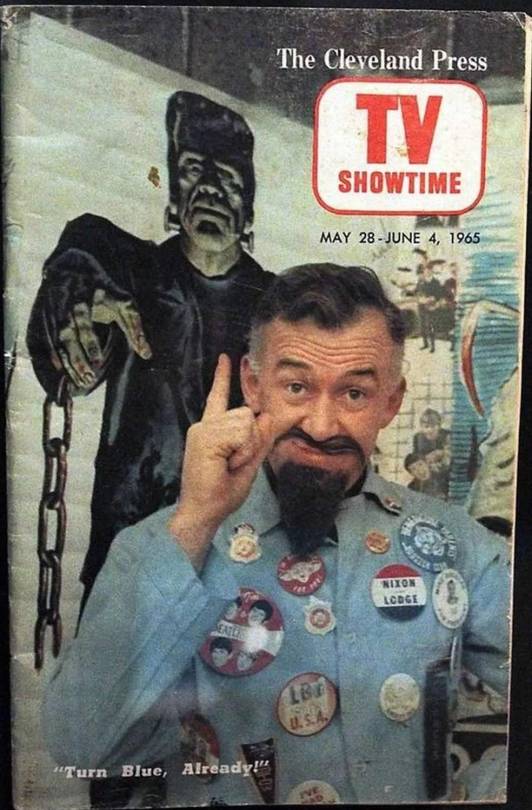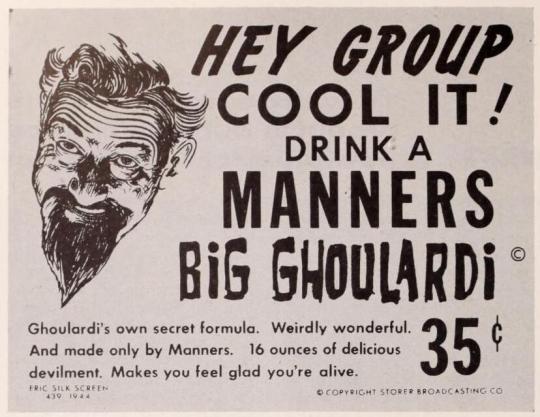#Ghoulardi
Text
Aaron Lange, Peter Laughner, and the Terminal Town of Cleveland, Ohio
Cleveland-based artist, Aaron Lange, tackles his first graphic novel, Ain't It Fun -- a deep dive into the oily depths of the Rust Belt's most influential music town, it's most mythological misfit, it's oft-forgotten artistic and political streaks, and beyond...
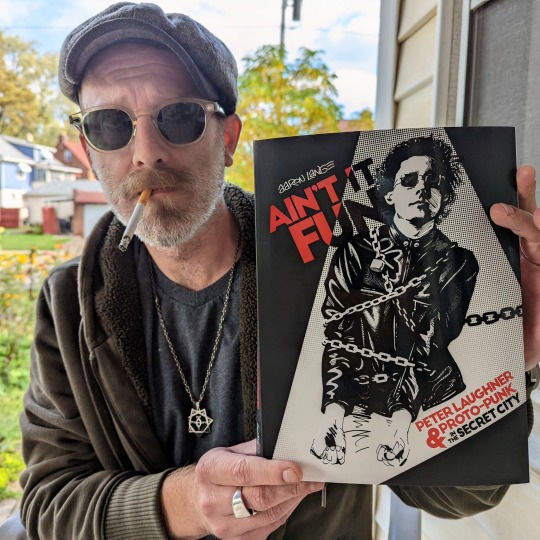
Aaron Lange and his book, 2023 (Photo by Jake Kelly)
--------------------------------------
There’s a recurring line in Aaron Lange’s remarkable new graphic novel, Ain’t It Fun (Stone Church Press, 2023), that states, “Say the words out loud. The River isn’t real.” The river Lange was speaking of is the Cuyahoga, that infamously flammable mass of muck that dumps out into Lake Erie.
Peter Laughner (the ostensible topic of Lange’s book) was an amazing artist who probably could’ve ditched the banks of the Cuyahoga for more amenably artistic areas back in his early 1970s heyday. Aside from his frequent pilgrimages to the burgeoning NYC Lower East Side scene (where he nearly joined Television) and a quickly ditched attempt to live in California though, he mostly stuck around northeast Ohio.
While desperately trying to find his sound and a workable band, Laughner smelted a post-hippie, pre-punk amoebic folk rock, and formed the influential embryonic punk band, Rocket from the Tombs, which later morphed into Pere Ubu. All of which – lumped up with other rust-belted oddballs like electric eels, Mirrors, DEVO, the Numbers Band, Chi-Pig, Tin Huey, Rubber City Rebels, and more – essentially helped formed the “proto-punk” template.
youtube
Laughner was also a rock writer of some regional renown, and contributed numerous amphetamine-fueled articles to regional mags like The Scene and Creem -- mostly concerning where Rock'n'Roll was going, colored as he was by the Velvet Underground, the Stooges, David Bowie, and Roxy Music playing in Cleveland a bunch of times around his formative years.
Sadly, in June 1977, Laughner died of acute pancreatitis at age 24. Aside from the first two seminal Pere Ubu 7-inch singles, the rest of Laughner’s recorded output was just one very limited self-released EP and, posthumously, a great double-LP comp of demo and live tracks, Take the Guitar Player for a Ride (1993, Tim Kerr Records). A surprisingly large batch of unreleased lost demos, radio shows, and live tapes appeared on the beautiful and essential box set, Peter Laughner (Smog Veil Records, 2019), that brought Laughner’s legend just a few blocks outside of Fringeville, as it received universally great reviews….
youtube
The Dead Boys became the most well-known act of that mid-70s Cleveland scene, though that only happened once they high-tailed it to NYC. Aside from DEVO, Chrissie Hynde, and the Waitresses (all of whom did their own versions of high-tailing it), nearly every other act in that fertile Cle-Akron proto-punk vortex soon dissipated, eventually getting the cult treatment at best.
Cleveland is indeed right there with NYC and London as punk ground zero, but Americans tend to equate buyable products as proof of import, so shockingly, the Pagans and The Styrenes just aren’t the household name they should be.
Decades of tape-trading stories, sub-indie label limited releases, and fanzine debates kept the mythology of those acts barely breathing underneath the end of the milennium’s increasingly loud R'n'R death knell. And as that mythology slowly grew, the fans and even the musicians of the scene itself still wonder what it all meant.
Which, as you dig deeper into Ain’t It Fun, becomes the theme not just about the legendary rocker ghost of Peter Laughner, but of Cleveland itself. Ala Greil Marcus’ classic “hidden history” tome, Lipstick Traces, Lange interweaves Laughner’s self-immolating attempts at Beatnik-art-punk transcendence with a very detailed history of Cleveland, with its insane anti-legends and foot-shooting civic development.
Like much of the dank, rusted, and mysterious edges of the one-time “Sixth City,” the Cuyahoga has been cleaned up since, though I still wouldn’t suggest slurping up a swallow if you’re hanging on the banks of the Flats. I grew up in Cleveland and visit as often as I can because it’s an awesome place, no matter what they tell you. Or maybe, because of what they tell you.
If you are keen to swim down through the muck and mire of Cleveland’s charms, you don’t just get used to it, you like it. As for the “Cleveland” that the City Fathers have always tried so vainly to hype, us hopelessly romantic proto-punk fanatics say to those who would erase Cleveland’s fucked-up past and replace it with that weird fake greenspace underneath the Terminal Tower: “The City isn’t real.”
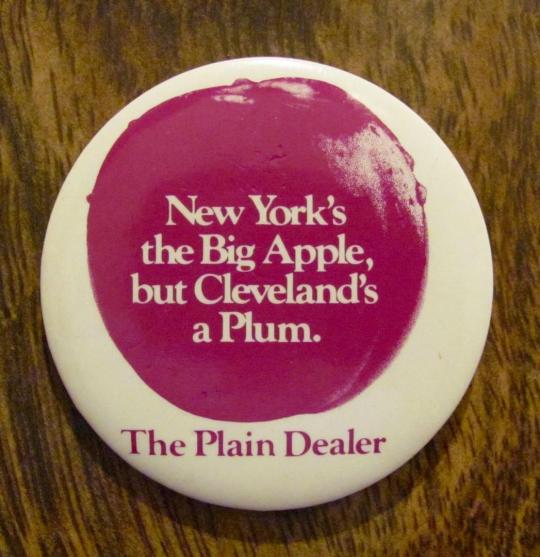
-------------------------------------
Give us a quick bio.
Born in Cleveland, 1981. We moved to the west side suburbs when I was six. My parents didn’t listen to much music, and I don’t have older siblings. So I didn’t really listen to music at all until I was in high school, and I didn’t listen to any of the grunge or ‘90s stuff that was popular. I got real into the Beatles when I was in ninth grade, and at some point I got the Velvet Underground’s first album from the library because I saw Andy Warhol’s name on the cover. I didn’t know anything about them, so that was a real shock. I probably first heard Iggy Pop via the Trainspotting soundtrack, and pretty soon after I started getting into punk and generally more obscure stuff. Now I listen to more electronic stuff, ambient stuff. I also like most anything that falls under the broad “post-punk” umbrella. I really hate “rama-lama ding-dong” rock and roll.
What came first – music or drawing interest?
Drawing. I was always drawing… I’ve been a semi-regular contributor to Mineshaft for many years, which is a small zine/journal that features a lot of underground comix related stuff, but also has a beatnik vibe and includes poetry and writing. I’ve done the odd thing here and there for other zines, but I don’t really fit in anywhere.
Don’t really fit it – I feel that phrase describes a lot of the best / more influential Ohio musicians / bands. Did you feel that kind of feeling about Peter as you researched and wrote the book?
Peter was well liked, and he knew a vast array of people. If anything, he fit in in too many situations. He was spread thin.
When you lived in Philly, did you get a sense of any kind of similar proto-punk scene / era in that town? I sometimes, perhaps jingoistically, think this particular kind of music is almost exclusively confined to the Rust Belt.
I lived in Philly for nearly 11 years. As far as the old scene there, they had Pure Hell. But back then, anybody who really wanted to do something like that would just move to NYC.
So, is there a moment in time that started you on a path towards wanting to dig into Cleveland’s proto-punk past like this?
It was just something I had a vague interest in, going back to when I first heard Pere Ubu. And then later learning about the electric eels, and starting to get a feeling that Cleveland had a lot more to offer than just the Dead Boys. The Rocket from the Tombs reunion got things going, and that’s when I first started to hear Laughner’s name. A few years later, a friend sent me a burned CD of the Take the Guitar Player for a Ride collection, and I started to get more interested in Peter specifically.
Despite any first wave punk fan’s excitement about a Laughner bio, this book is moreso a history of Cleveland, and trying to connect those odd underground, counterculture, or mythological connections that the Chamber of Commerce tends to ignor as the town’s import. Was there a moment where you realized this book needed to go a little wider than only telling the tales of Laughner and the bands of that era? (Not that there’s anything wrong with that!)
Very early on I realized that none of this would make sense or have any true meaning without the appropriate context. The activities of the early Cle punk scene need to be viewed in relation to what was going on in the city. I think this is just as true with NYC or London – these were very specific contexts, all tangled up in politics, crime, rent, television, and also the specifics of the more hippie-ish local countercultures that preceded each region. You’ve got Bowie and Warhol and all that, but in Cleveland you’ve also got Ghoulardi and d.a. levy. Mix that up with deindustrialization and a picture starts to form.
youtube
So when did you decide on doing this book? You’ve mentioned this was your first attempt at doing a full graphic novel – and boy, you went epic on it!
I did a short version of Peter’s story back when I was living in Philadelphia. But upon completing that version – which I now think of as a sketch – it became clear that there was a lot more to say and to investigate. I spent about a year just thinking about it, forming contacts with some people, and tracking down various reference materials like records, zines, books, etc. Then my wife got a new job at Cleveland State University, so we left Philly. Once I landed back in Cleveland I started working on the book in earnest.
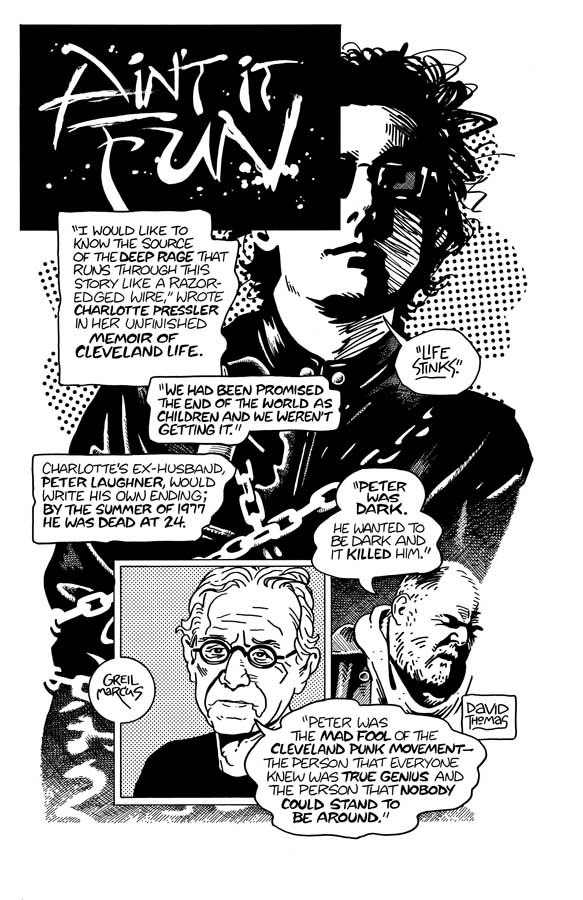
Page from Ain't It Fun -- all book images courtesy of the author.
By any chance was Greil Marcus’ book, Lipstick Traces (1989), an inspiration, as far as the “hidden history” factor, the trying to connect seemingly unconnected and lost historical footnotes into a path towards the culture’s future?
Yes. I read Lipstick Traces when I was around 19 or 20, and I’d never seen anything like it before. It really blew my mind, all the stuff about the Situationists and Dadaists and all that. Later on, I read Nick Tosches’ Dean Martin biography, Dino, and that was another mind blower. Another major influence is Iain Sinclair.
Ah Dino, another Ohio native. So, Laughner’s one-time partner, Charlotte Pressler’s book is mentioned, and I’ve seen it referenced and talked about for years – any inside word on if/when she might have that published?
Charlotte never wrote a book, though she did co-edit a book that collected the work of local poets. As far as her own writing, she’s done all manner of essays and poetry, and probably some academic writing that I’m not familiar with. As far as her completing “Those Were Different Times”— which was intended as a total of three essays— I’ve got some thoughts on that, but it’s not really my place to comment on it.
Pressler sounds like a very serious person in your book, as you say, she was kind of older than her years. But how was she to talk to?
Charlotte is serious, but she’s not dour. She’s got a sense of humor and she’s very curious about the world, always looking to learn new things. She’s an intellectual, and has a wide array of interests. We get along, we’re friends.
The fact that the town’s namesake, Moses Cleveland, left soon after his “discovery” and never came back – that’s like a template for how people envision a town like Cleveland: nice place to grow up, but you want to get out as soon as you’re legal. Even the musicians of the area might’ve agreed with that sentiment, even if many never left. Do you think that has changed?
I’m glad I left Cleveland, but I’m also glad I came back. First off, my family is here. Second, the cost of living is still reasonable. I don’t know how people live in New York. I never have any money. I’d make more money if I had a full-time job at McDonald’s. That’s not a joke, or me being self-deprecating. How do artists live in New York? How do they afford rent and 20 dollar packs of cigarettes? I’m just totally confused by the basic mechanics of this. So yeah, I’m in Cleveland. It’s not great, but what are my options? I can’t just go to Paris and fuck around like a bohemian. I would if I could.
In Ain't It Fun, you reveal that one of the seminal Cleveland scene dives, Pirate's Cove, was once a Rockerfeller warehouse – these kind of enlightening, almost comically perfect metaphors pop up every few pages. Not unlike the mythology that can sometimes arise in musician fandom, I wonder if these are metaphors we can mine, or just an obvious facts that the town drifted down from a center of industry to relative poverty.
“Metaphor” might be at too much of a remove. These facts, these landmarks — they create a complex of semiotics, a map, a framework. The city talks through its symbols and its landscape. If you submit to it and listen, it will tell you secrets. There is nothing metaphorical about this.
Is it a sign of privilege to look on destitution as inspiration? I’m guessing the sick drunks at Pirate’s Cove in 1975 weren’t thinking they were living in a rusty Paris of the ‘30s. Though I will say a thing I really loved about your book was that, for all its yearning and historical weaving, you still stick to facts and don’t seem to over-mythologize or put any gauze on the smog, like “Isn’t that so cool, man.” You capture the quiet and damp desperation of that era and Laughner’s milieu.
Poverty, decline, decay, entropy – these things are real. By aestheticizing them we are able to gain some control over them. And once you have control, you have the power to change things. This is not “slumming.” “Privilege” has nothing to do with it.
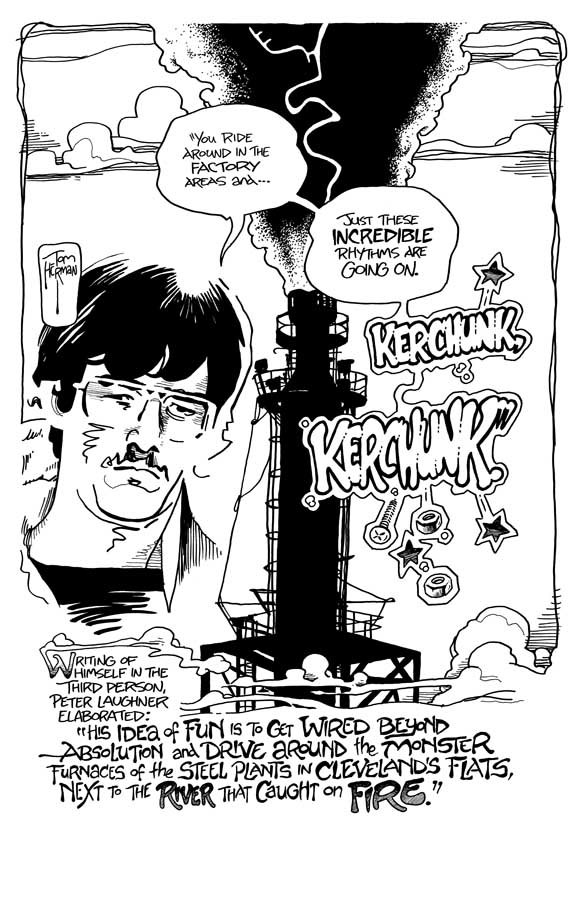
Page from Ain't It Fun
Do you know why the Terminal Tower (once the second tallest building in the world when it opened in 1928) was named that? It seems somewhat fatalistic, given the usual futurist positivism of the deco design era.
Terminal as in train terminal. It really pisses me off that there was once a time where you could go there and catch a train to Chicago or New York. It’s infuriating how this country dismantled its rail systems. And the Terminal Tower isn’t deco, but I think it is often confused with that style just by virtue of not being a gigantic rectangle. In that sense it does have more in common with a deco structure like the Chrysler building. Honestly, if you are looking for deco you might find more notable examples in Akron than you would Cleveland.
I notice a kind of – and bear with my lesser abilities to describe illustrative art – swirly style in your work that kind of aligns with art deco curves, maybe some Gustav Klimt…? In general, who were some illustrative inspirations for you early on?
That “swirly” style you describe is art nouveau. Deco came after that, and is more angular and clean. Additionally, a lot of underground comix guys were also poster artists, and there was often a nouveau influence in that psychedelic work – so there’s a bit of a thread there. As far as Klimt, I came to him kinda late, but I love him now.
The music of many northeast Ohio bands of that era has been generally tagged as “industrial” (the pre-dance industrial style, of course), cranky like the machinery of the sputtering factories in the Flats, etc… My guess is maybe the musicians were already finding used R'n'R instruments in thrift stores by that time, which would add a kind of layer of revision, turning old things into new sounds. Did you hear about of any of that? Or were there enough music stores around town? I know DEVO was already taking used instruments and refitting them; or electric eels using sheet metal and such to bang on…
I’m not a musician, so I don’t know anything about gear or stuff like that. I do know that Allen Ravenstine made field recordings in the Flats, and utilized them via his synthesizer. Frankly, I wish more of the Northeast Ohio bands had taken cues from Ubu and early Devo, because an “industrial” subculture definitely could have formed, like it did in England and San Francisco. But that never really happened here.
youtube
That kind of music was pretty popular on college radio and in a few clubs in Cleveland, though not many original bands with that sound arrived, aside from Nine Inch Nails who quickly took his act elsewhere… So in the book you mention local newsman, Dick Fealger. My memories of him are as a curmudgeon whose shtick was getting a little old by the time I was seeing him on the news, or his later opinion columns. Kinda your classic “Hey you kids, get off my lawn” style. You rightly paint him as a somewhat prescient reporter of the odd in his earlier days, though. I once had to go to a friend’s mother’s funeral, and in the next room in the funeral home was Dick Feagler’s funeral. I always regret not sneaking over and taking a peak into it to see who was there.
I like Feagler in the same way that I liked Andy Rooney on 60 Minutes. These were people that my grandparents liked. So I suppose my appreciation for Feagler is half nostalgia, half irony. I like cranks, grumps, letter-writers, street prophets. I like black coffee, donuts, diners, and blue plate specials – that’s Feagler’s world, the old newspaper world. Get up at 6 am and put your pants on, that kinda thing.
Yeah, I still found Feagler kinda funny, but like Jane Scott, while respect was always there, by the later ‘80s/’90s, both were set into almost caricatures who were kind of resting on their laurels.
Yeah, I remember seeing Jane at some random Grog Shop show back in the ‘90s, and I was kinda impressed. But no, she was never really cool. Jane was pure Cleveland, her career couldn't have happened anywhere else.
I remember seeing her sit right next to a huge house amp at the old Variety Theater for the entire duration of a Dead Kennedys show, taking notes for her review. Pretty impressive given her age at that point.
You also make a point of carving out an important space for The Damnation of Adam Blessing, a band that seems to get forgotten when discussing Cleveland’s pre-punk band gaggle. I find that interesting because in a way, they are the template for the way many Ohio bands don’t fit into any exact genre, and so often people don’t “get” them, or they’re forgotten later.
Damnation worked as a good local example for that whole psychedelic thing. They were very ‘60s. While the James Gang on the other hand, was more ‘70s— the cracks were starting to show with the ‘70s bands, they were harder and less utopian. Damnation feels more “Woodstock,” so they were useful to me in that regard.
I must add – for years I thought it was pronounced Laugh-ner, as in to laugh, ha ha, not knowing the Gaelic roots. Once I learned I was pronouncing it wrong, I still wanted to pronounce it like laughing, as it seemed to fit so darkly correct with how his life went, and Cleveland musicians’ love of bad puns and cheap comedians and such… Of course when I learned that it was an “ethnic” name, it made it that much more Cleveland.
Yeah, everybody says his name wrong. I used to too, and had to really force myself to start saying it as Lochner. But everybody says Pere Ubu wrong as well – it’s Pear Ubu.
I hate any desecration of any artwork, but I always loved the blowing up The Thinker statue story, as it seemed such a powerful metaphor of the strength of art, and Cleveland itself – the fact that The Thinker himself still sits there, right on top of the sliced-up and sweeping shards from the blast. It’s still there, right? And isn’t it true that there are like three more “official” Thinker statues in the world?
Yeah, I don’t condone what happened, but it is kinda cool. As a kid, the mutilated Thinker had a strong effect on me — I couldn’t have put it into words at the time, but I think it gave me a sense of the weight of history. It’s almost like a post-war artifact in Europe, something that is scarred. And yes, it’s still there outside the museum. And it’s a cast. I think there might be five official ones, but I’d have to look that up. If you are ever in Philadelphia, swing by the Rodin museum and check out The Gates of Hell.
I have only become a bigger fan of Laughner’s as the years pass. But there is something to the critique that perhaps he never really found his singular sound; that he was copping bits from Lou Reed and Dylan, and couldn’t keep a band together to save his life. And there was supposedly a feeling among some in the NYC scene that he was a bit of a carpetbagger.
youtube
Everybody has their influences, so Peter wasn’t in any way unique in that sense. I know he has a reputation for doing a lot of cover songs — which is true — but he also wrote a lot of originals, and there are some damn good ones which are still unreleased. “Under the Volcano” is just one such unheard song which I mention in my book, but there are others. As far as finding his own singular sound, he probably came closest to that with Friction. That group borrowed heavily from Television and Richard Hell, but also drew upon Richard Thompson and Fairport Convention. And when you think about it, those were really unlikely influences to juxtapose, and it created something original. Frustratingly though, Friction never achieved their full potential, as Peter was already losing it.
Yeah, Friction is kind of way up there with the “What if” bands… It’s interesting that for all his legend as a proto-punk figure, perhaps Laughner’s signature songs – Sylvia Plath” and “Baudelaire” – were gorgeous acoustic numbers. Though of course those early Pere Ubu songs were proto-punk and post-punk templates, somehow...
youtube
I honestly don’t know what happened with Ubu, as it is pretty distinct from Peter’s other work. Thomas isn’t really a musician, so we can only give him so much credit with how that sound developed. I honestly don’t know. There just must have been some sort of alchemy between the various players, and Thomas understood it and was able to encourage and guide it in the projects that followed over the years.
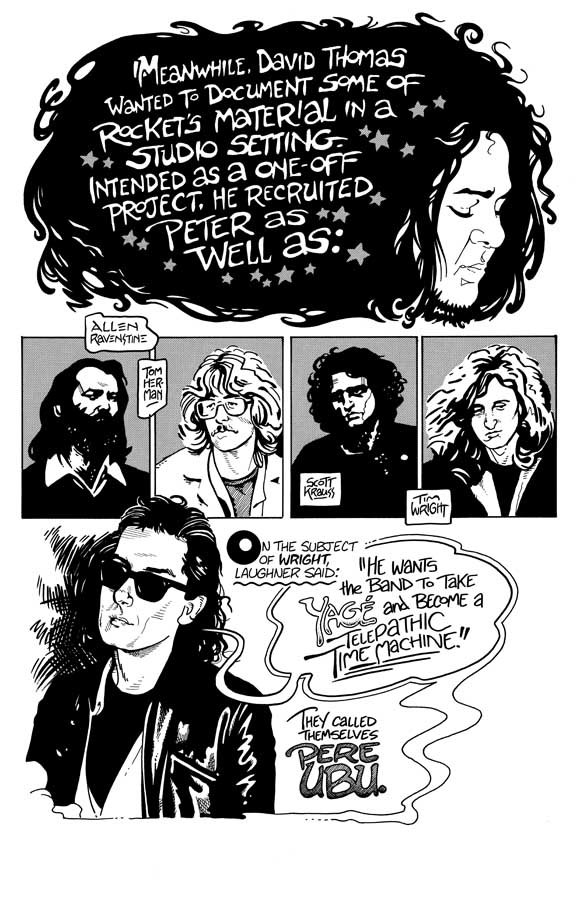
Page from Ain't It Fun
You also didn’t really detail Pere Ubu’s initial breakup – was there just not much to say?
Yeah, I think I mentioned it, but no, I didn’t really get into it. Pere Ubu is kind of a story unto themselves. But it might be worth mentioning here that Home and Garden was an interesting project that came out of that Ubu breakup. And Thomas also did some solo albums, but I’m not as familiar with those.
youtube
Yeah, I saw Home and Garden a few times way back, good stuff. You’ve mentioned to me that there were some people that didn’t want to talk to you for the book; and that people were very protective of Peter’s legacy and/or their friendship with him. To what do you attribute that?
It has everything to do with Peter’s early death. Some people are very protective of how Peter is remembered. And I think some people weren’t exposed to Peter’s dark side, so when they hear those descriptions of him it strikes them as untrue. I think Peter showed different sides of himself to different people.
I kind of felt as I was reading that you might say more about Harvey Pekar, as not only is he an interesting figure, but the most famous graphic novelist from Ohio, and I assume an inspiration of your’s.
Pekar’s great. Especially the magazine-size issues he was doing in the late ‘70s up through the ‘80s. It was important to me to include him in the book. But Pekar was a jazz guy, and that’s a whole other story, a whole other tangled web.
So, Balloonfest! Hilarious. I almost forgot about that. But I do remember Ted Stepien owning the short-lived Cleveland professional softball team; and for a promotion, they dropped softballs off the Terminal Tower, and if you caught one you won $1,000 or something. Do you recall that? It’s one of my favorite fucked-up Cleveland stories. Balls smashed car roofs, and cops immediately told people to run away.
youtube
Yeah, I’m aware of that baseball stunt. I generally try and stay away from anything even remotely related to professional sports teams — it gets talked about more than enough elsewhere. Oddly, I am interested in athletes who work alone, like Olympic skiers. I’m attracted to that solitary focus, where the athlete isn’t competing against other teams or players, but more competing with the limits of the human body, competing with what the physical world will allow and permit, that whole Herzog trip. I’m also interested in the Olympic Village, as this artificial space that mutates and moves across time and across continents.
As far as Balloonfest, I still watch that footage all the time. I use it as a meditation device. I’ll put it on along with Metal Machine Music and go into a trance.
youtube
A few years ago, as I am sure you are well aware, noted British punk historian Jon Savage put together a Soul Jazz Records comp of Cleveland proto-punk called Extermination Nights in the Sixth City. I grew up in Cleveland, lived in Columbus for awhile, and I never heard it called “the Sixth City.” Have you? If so, what does it refer to?
Nobody calls it that anymore. It’s an old nickname back from when Cleveland was literally the sixth largest city in the country.
I’d guess Ain’t It Fun was a tiring feat to accomplish. But do you have another book in the works? And if someone wanted to option Peter’s story for a movie, would you sign on? I personally dread rock biopics. They’re almost universally bad.
Yeah, I’ve got an idea for another book, but it’s too early to talk about that. As far as biopics, they are almost always bad, rock or otherwise. Rock documentaries are often pretty lousy too. A recent and major exception would be Todd Haynes’ Velvet Underground documentary, which is just goddamn brilliant. A film about Peter in that vein would be great— but there’s just no footage to work from. He didn’t have Warhol or Factory people following him around with a camera. So unless somebody like Jim Jarmusch comes calling, I won’t be signing off on movie rights any time soon.
Unless there is more you’d like to say, thanks, and good luck with the book and future ventures!
Stone Church Press has a lot of projects planned for 2024 and beyond, and I encourage anyone reading this to support small publishers. There is a lot of very exciting stuff going on, but you have to work a little to find it. Amazon, algorithms, big corporate publishers — they’re like this endless blanket of concrete that smothers and suffocates. But flowers have a way of popping up between the cracks.
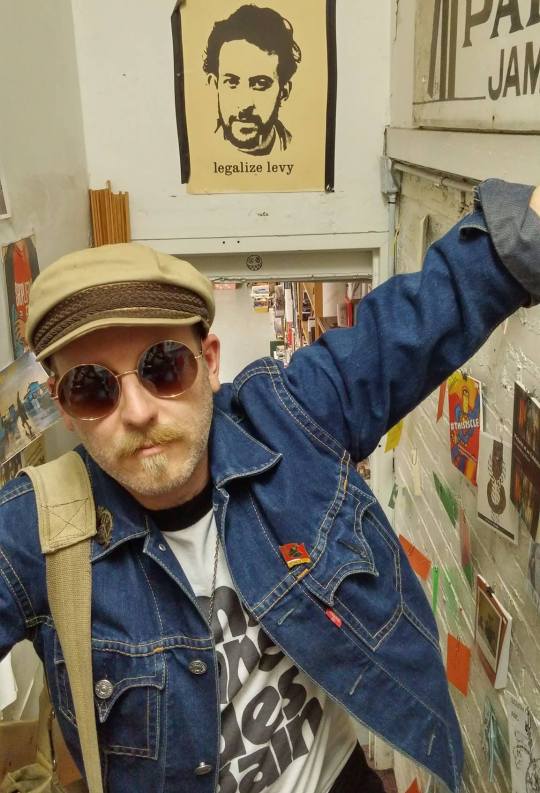
Aaron Lange, 2023 (Photo by Jake Kelly)
#punk#cleveland punk#velvet underground#peter laughner#pere ubu#protopunk#clevelandrocks#cleveland#devo#nycpunk#1970s rock#aint it fun#Ghoulardi#smog veil#guns n roses#ohio punk#ohio#punk rock#garage punk#biographies#eric davidson#lou reed#television#dead boys#rocket from the tombs#Youtube
17 notes
·
View notes
Text
Biden needs to tell Netanyahu to "Cool it with the boom-booms."
0 notes
Video
youtube
Michael Penn - Try (Resigned, 1997)
Directed by Paul Thomas Anderson
http://cigsandredvines.blogspot.com / http://michaelpenn.com
#michael penn#paul thomas anderson#try#resigned#1997#1990s#video#music video#rock#pop#boogie nights#philip seymour hoffman#ghoulardi film company#robert elswit#thomas jane#brendan o'brien#Fifty Seven Records#epic#melora walters
2 notes
·
View notes
Text
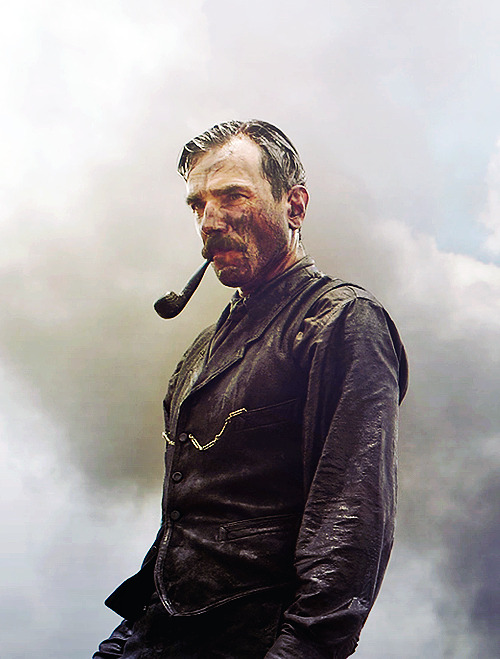
Movie poster.
There Will Be Blood is a 2007 American epic period drama film written and directed by Paul Thomas Anderson, loosely based on the 1927 novel Oil! by Upton Sinclair.[4] It stars Daniel Day-Lewis as Daniel Plainview, a silver miner turned oilman on a ruthless quest for wealth during Southern California's oil boom of the late 19th and early 20th centuries. Paul Dano, Kevin J. O'Connor, Ciarán Hinds, and Dillon Freasier co-star.
The film was produced by Ghoulardi Film Company and distributed by Paramount Vantage and Miramax Films. At the 2008 Berlin International Film Festival, it won the Silver Bear Award for Best Director and a Special Artistic Contribution Award for Jonny Greenwood's score. It grossed $76.2 million worldwide on a $25 million budget.
There Will Be Blood received acclaim for its cinematography, direction, screenplay, score, and the performances of Day-Lewis and Dano. Day-Lewis won the Academy Award, BAFTA, Golden Globe, Screen Actors Guild, NYFCC and IFTA Best Leading Actor awards for the role. It has been widely regarded by critics as one of the greatest films of the 21st century,[5][6] and it appeared on many critics' "top ten" lists for 2007, including the American Film Institute,[7] the National Society of Film Critics, the National Board of Review, and the Los Angeles Film Critics Association. At the 80th Academy Awards, the film was nominated for eight Oscars (tying with another Miramax/Paramount Vantage co-production No Country for Old Men). The nominations included Best Picture, Best Director and Best Adapted Screenplay for Anderson. Along with Day-Lewis' Oscar for Best Actor, Robert Elswit won the award for Best Cinematography. Source: Wikipedia
#daniel day lewis#there will be blood#film#movies#movie stars#acting#actors#pipe men#vintagemen#pipesmoking#pipemen#vintage men#pipes#smoking pipe
10 notes
·
View notes
Text
I don’t like scary movies.
Honestly I don’t see the point. Why would anyone shell out good money for two hours of anxiety and the possibility of indelible nightmares? The kind that revisit the back of your eyes on rainy nights of insomnia.
I can’t stand jump scares, needle-in-your-eye shock value, or the sight of gelatinous insides. I don’t like spook-house rides or things that go bump in the night. Blame it on my uncle, who used to pop out from behind the couch and frighten the bejesus out of me when I was way too young to get the joke.
Bob is different. He’s sweet, but kind of an idiot. Loves all that shit, from creepy occult to slasher flicks. Has a Creature from the Black Lagoon beer tap in his man cave, and wears a Ghoulardi lapel pin.
So when I find him studying the Bijou Theater Revival Series calendar, I know what’s coming.
“Hey Nancy, are we free the fourteenth?”
“I have no idea. Why?”
“The Bijou is showing The Tingler. One time only. They haven’t screened it since it came out in nineteen-fifty-nine.”
“Have fun.”
“Aw, Nance. Don’t be such a scaredy cat. Vincent Price. Old and corny. Not scary. Not to mention the Percepto! Fun stuff.”
“Percepto? Is that an antacid?”
Bob makes his stink face. “Percepto is a William Castle scare gimmick. Some say his greatest. Theaters would wire some of the seats with electricity. Just enough to give whoever was sitting there a little zap. When the Tingler showed up on screen, you not only saw it, you felt it.”
“Cute.”
“So c’mon then. Show me how much you love me.”
“Nope.”
“I’m telling you it’s not scary. Pure camp.”
“To you maybe. Remember, I tense up watching Abbott and Costello Meet Frankenstein.”
“Trust me, you want to see this. Vincent Price performs one of the first on-screen experiments with LSD. And when it was originally released, the distributors sent aircraft deicing motors left over from World War Two to power the seats.”
“I can’t process all that. I’ll come back to the LSD. What motors?”
“Deicing. Used to defrost airplane wings.”
“Fascinating, but no sale. Believe me, you’ll have a better time without me.”
There is a long silence as Bob mulls his options. “I’ll watch The Crown with you.”
“Whoa. You really want this.”
“Nobody wants to ride a rollercoaster alone.”
“I’m not riding any rollercoasters.”
“It’s a metaphor.”
I have three episodes left. For Bob it would be the ultimate sacrifice.
“Deal,” says I.
#
Originally built as a vaudeville house in the late nineteenth century, the Bijou is the oldest movie theater in the city, a treasured gem. A shimmering gold curtain majestically parts to reveal a screen the size of O’Toole’s desert. A monstrous Phantom of the Opera chandelier hangs from an ornamental plaster ceiling. Thalia and Melpomene masks laugh and frown from the proscenium.
This Saturday morning the lobby is crowded. Bob said The Tingler had a cult following, and he wasn’t kidding. Hipsters and geeks stand backed up to the doors for popcorn and jujubes as Bob holds up the box office line, contemplating the seating chart.
No thanks to Covid, you now have to pre-select your seats which Bob takes very seriously. He finally chooses two in third row center, seats 13 and 14. I’m normally a five-to-seven row back person, but the seat chart was already pretty full. Bob looks to me for the okay, I smile weakly and nod.
With any luck I’ll be taking a nap.
I get a hot tea and we sidestep to our seats, counting the numbers on the little brass armrest plaques. I settle into #14 comfortably. At five-four and just a bit of a squeeze into a size eight, most theater chairs give me room to spare. Bob, well past his football days and settling farther into life’s couch, has to wriggle into his.
Bob goes through his pre-show ritual, cleaning his glasses on his tee shirt, and digging out the baggie of homemade Chex Mix he’d smuggled in.
The house lights go down so slowly you don’t realize it’s happening, like your vision dimming before sliding into dream state. Or what I imagine happens in a slow death.
The movie starts with a man in a suit, his back to camera, sitting in a director’s chair. On cue, he stands and turns to address us in glorious black and white.
“I’m William Castle, director of the motion picture you are about to see. I feel obligated to warn you that for the first time in motion picture history, some members of the audience, including you, will actually play a part in the picture and feel some of the shocking sensations experienced by the actors on the screen.”
Bob nudges me. “Not all these seats may be wired. Be ready to switch if we don’t feel anything.”
Castle continues. “But don’t be alarmed. At any time you are conscious of a tingling sensation, you may obtain immediate relief by screaming.”
Now comes a montage of people screaming. Lots of them. Little mortised screaming faces zooming towards the audience, getting bigger until they dominate the screen. All screaming.
So much for my nap.
Large white type wipes across the frame. “Don’t be embarrassed to scream, it may save your life!” Followed by… “Guarantee: The Tingler will break loose in this theater while YOU are in the audience.”
Bob’s knees are knocking in anticipatory delight. Like I said, he’s an idiot, albeit a lovable one. But he was right about one thing. This is so dumb I’m actually having fun.
The movie starts with the same hokey set up you’ve seen plenty of. Mild-mannered, lab-coated Vincent Price is obsessed with the physical effects of fear. He cuts open lots of cadavers who died in horrific circumstances, and determines that extreme fear can actually crack your spine.
I look over at Bob, carefully chewing his Chex Mix so as not to make sounds in his head.
Ten minutes later a deaf mute woman has a hallucinatory nightmare that she’s being chased by an axe murderer and other scary stuff, and dies in a fit of silent agony. “Cause of Death,” says the coroner’s report, is “Extreme Fright.”
Vincent Price performs the autopsy and discovers a parasite that looks like an Italian sub-sized grub worm attached to the deaf mute’s spine. He hypothesizes that the parasite feeds on fear and, unless that fear is somehow released, can grow strong enough to break your spine. Vincent dubs the creature, “The Tingler.”
With furrowed brow, Vincent returns to his lab for further research, and decides to induce his own fear by taking a dose of LSD. He freaks out, imagining skeletons are after him and generally overacts his googly eyes out. But when he starts to scream, the apparitions stop.
Bottomline: The only way to survive the Tingler is to scream your bloody head off. And since the deaf mute woman couldn’t scream, she went kaputski.
I can’t believe I’m actually following this.
I should add that after Vincent Price pulls the Tingler off the woman’s spine, he puts it in a bag and takes it home, like a freakish carnival goldfish. Anyway, you won’t believe this, but the Tingler escapes and hits the town, eventually wandering into a crowded movie theater.
So now we’re sitting in a movie house, watching a movie of people watching a movie in a movie house. The fourth wall comes down, and all hell breaks loose. Here we go. Let the chair-zapping begin.
I’ll admit it was a pretty neat trick. Vincent Price runs into the theater on screen. The audience turns to look at him, and us. Vincent’s voice sounds as if he’s at the back of our theater, and we turn around like suckers just in case he’s really there. He’s not. We turn back to the screen in time to see a woman in the movie get attacked by the Tingler. She screams. A woman somewhere in the back of our theater (possibly a plant?) screams. We all turn around again.
Which theater am I supposed to be paying attention to? Where am I supposed to look? Somebody’s going to get a case of whiplash.
There are over-the-top comic screams scattered around the Bijou, though not nearly as many as I expected. My best guess is the wired seats are few and far between and the voltage is weaker than a coin-operated motel Magic Fingers massage. Incidentally I don’t feel a thing, which as far as I’m concerned, is a gift. I would’ve paid twice as much for an unwired seat.
Bob obviously has one. He is bellowing like a stuck gator. I actually jump, sloshing tea on my corduroys.
I make out the silhouette of an usher coming down the aisle, grazing people on the back of their necks with what looks like a rubber lobster. Everybody—our live audience and the on-screen audience—is screaming together.
But Bob is shrieking like he means it, hands clawing his face, wearing an expression of sheer terror. Twisted, strained, quivering.
What a ham.
He’s kind of creeping me out. I give him a shake. “Cool it,” I shush, which he ignores, beginning to twitch. His hands shoot out from his face, catching his eyeglasses, sending them flying in the dark.
The Tingler is running amok, both on the screen and in the form of two pimple-faced ushers and aforementioned rubber lobsters. People on the screen are running for their lives. People in our audience are hooting it up.
Suddenly the Tingler is silhouetted on the screen like it’s in our very own projection booth, slithering over the projector’s glass lens. The screen goes dark, as if the Tingler has shut down the projector. The theater plunges into total black, save the exit signs.
Somebody yells, I have no idea who or from where. “Ladies and Gentlemen, please do not panic. But scream! Scream for your lives!”
Bob isn’t epileptic, but you wouldn’t know it. Legs kicking wildly, bucking and convulsing. His screams are so loud he’s getting attention despite the chaos. Not the good kind. I clamp my hand over his mouth. His eyes bug out like ping pong balls. He swats at my hand, but I manage to hold it there.
The picture on screen resumes in time for us to see Vincent Price throw a net over the Tingler and save the day. The movie wraps up with a happy ending and a sigh of cornball relief.
I take my hand off Bob’s mouth. His head flops sideways, tongue lolling out, eyes rolled back. I hear myself scream.
#
The EMTs got there just before the cops. Bob was no response for a literal heart-stopping four-and-a-half minutes. In a fit of hysteria I told them to check his spine. A cool-headed woman asked for someone to restrain me while she applied a defibrillator, which, after several more shocks to Bob’s system, did the trick. A dopey eyed Bob smiled up at me. One of the sweetest smiles I’ve ever seen.
The theater manager stood by, a moon-faced guy in his thirties, quietly trembling in scuffed Oxfords. His eyes, vacant and hollow, began to water as Bob rejoined the living.
“I knew this was a mistake,” he said in a weak voice.
This guy was clearly damaged goods. I kept my mouth shut and let him get it off his chest.
“This stupid movie. Bad luck. Bad bad luck. I swore this theater would never show it again after what happened the first time, but I let them talk me into it. This is all on me.”
I stepped towards him. “Happened the first time? How much voltage was in those chairs anyway?”
Glazed eyes looked at me in incredulous anguish. “Are you insane? I wouldn’t wire those seats if my life depended on it. I don’t need that kind of karma.”
“Wait, are you saying nobody’s seat was electrified?”
“Absolutely not. At this point it’s like Rocky Horror. People just play along and scream on cue. The ushers follow the script and do the rubber lobster bit, but that’s it. The whole thing’s just a nostalgia goof. Where’d you get the idea we wired the seats?”
I looked over at Bob, telling the paramedic he was holding up four fingers when he was only showing three.
One of the cops was taking notes. “What did happen ‘the first time?’”
The manager sat on the lobby couch and took a deep breath.
“In nineteen-fifty-nine, when the distributor sent the film, for some reason they didn’t send the motors, just instructions on how to wire the seats. A low-voltage schematic, but my grandfather didn’t know his AC from his DC and hired some dumb kid to do it. Good kid, looking to impress my grandfather, pretending to know more than he did.
“Kid said he could handle it. Only he forgot the limit switch and neglected to ground it properly. Most of the seats worked okay, but one of them, with a direct line to the power source, was over amped. Four-thousand volts worth. Sizzled a man to his seat on opening night. Took a week to get rid of the smell of burnt hair. Haunted my grandfather for the rest of his life.
“Almost cost him the theater. Luckily, the deceased was a loner, no family, the courts took pity on the kid, and no charges were pressed. By some miracle, it stayed out of the papers.”
“That’s horrible. So why’d you show it?”
“I didn’t want to. State film board begged me at the behest of some anonymous donor with big bucks and a thing for fifties spook-show publicity stunts. Said this was the only theater that could do it justice. I refused. Then I got a call the tourism board, then the Mayor’s office and then the Mayor himself, for crying out loud.”
The manager hung his head. “They do a lot for this theater, and not only in state funding. They just nominated us for historic landmark status, which is a huge tax break. I caved.”
I heard Bob softly singing the Banana Splits theme song. Back to his old self. Nevertheless, they wanted to keep him overnight for tests. Said I could ride in the ambulance.
I had one last question, but was almost too afraid to ask. I have trouble enough sleeping as it is. “The man who died. Do you know what seat he was in?”
I shuddered at the answer, the same one you’ve already guessed. If I was a scaredy cat before, from here out, I’ll be a full-blown basket case.
0 notes
Photo

Accidentally referred to them as "The Vince Ghoulardi Trio." #HeyGroup #StaySickKnif (at Cleveland, Ohio) https://www.instagram.com/p/Civ32TpJso7/?igshid=NGJjMDIxMWI=
0 notes
Text

"Le plus étonnant étant que l’esprit du Shock Theater se retrouva cité comme une source d’inspiration, au même titre que d’autres jugées plus sérieuses, ou conformes, par des groupes comme Père Ubu ; les Cramps reprenant quant à eux le leitmotiv qu’Anderson adressait à ses ouailles à chaque fin d’émission, « Stay sick, and turned blue ! », quelque chose qu’on pourrait réinterpréter par un « Restez tarés, et allez jusqu’au bout », ou « Restez vous-mêmes, quoi qu’il arrive, et ne le perdez jamais »… Quelques années plus tard, sur un autre continent, le Russe Mirko Malékhine écrira : « Tous les enfants deviennent des hommes, mais peu d’hommes se souviennent qu’ils ont été des enfants », comme si la fonction principale des morts était de transporter, au gré du ciel, des molécules d’idées, de façons éparses, parfois désordonnées et déconstruites. Après tout, pourquoi pas : on ne savait toujours pas ce qui avait donné un jour l’idée aux singes de l’île de Bornéo de faire du feu à peu près au même moment que d’autres singes en Indonésie, sauf à considérer que l’un d’entre eux était parti en pédalo d’une rive à l’autre pour leur donner le mode d’emploi."
#ernieanderson #ghoulardi #socktheater #mediumlesjoursdepluie #frenchnovel #ernieanderson #paulthomasanderson #louis-stéphaneulysse
1 j
0 notes
Text

19 notes
·
View notes
Photo
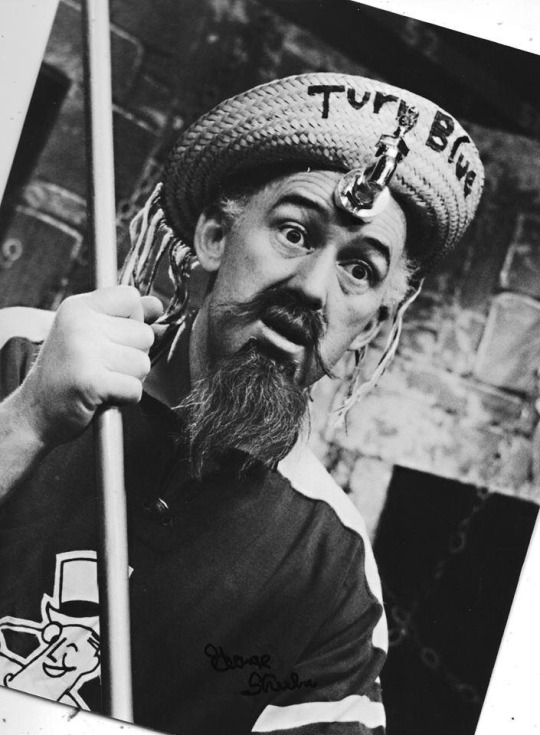
Cleveland horror host, “Ghoulardi”
7 notes
·
View notes
Photo






Ernie Anderson was one of the most successful and popular of the many regional late late horror hosts. His character Ghoulardi introduced old creature features in the Ohio market. He was already well-known as a local radio personality when he created the Ghoulardi persona. Believe it or not, he is the father of filmmaker Paul Thomas Anderson.
#Ernie Anderson#Ghoulardi#horror hosts#regional television#creature feature#chiller theater#late late show#Cleveland#Ohio#WSPD#Toledo
325 notes
·
View notes
